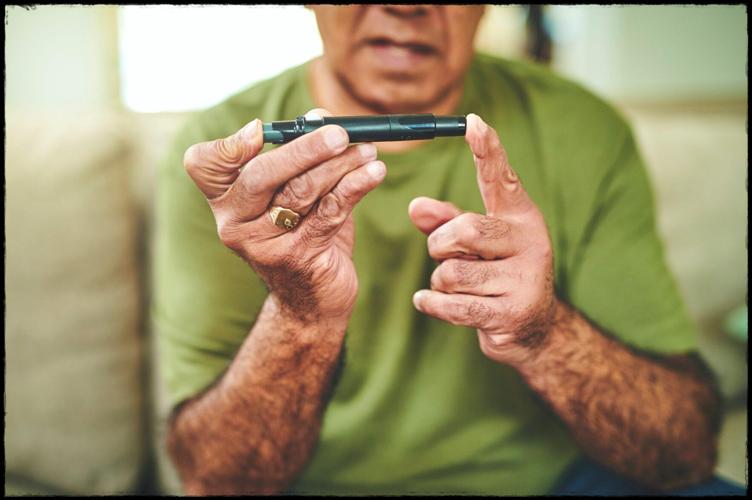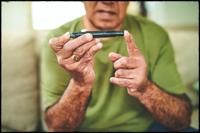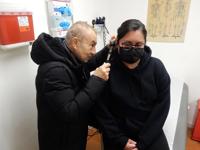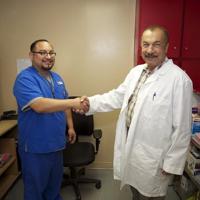The Clinica Medica San Miguel is a go-to place for Latinos living in Los Angeles who are struggling with Type-2 diabetes. Today, 70% of Hispanic adults have been diagnosed with diabetes, more than non-Hispanic white adults, according to the U.S. Health and Human Services. Clinica Medica San Miguel in LA is operated by Dr. Mahfouz Michael, who uses an unorthodox, yet proactive, approach to determine whether a patient is pre-diabetic.
This approach focuses on testing fasting insulin levels. By preventing and educating patients, he helps them avoid a diagnosis altogether. A comprehensive approach is taken with patients who have already been diagnosed with the disease. Michael said that he understands that the risk factors associated with their family, career, social and cultural backgrounds have led them to this point in their lives. In recent years, he has successfully helped more than 200 patients manage the disease without the need for insulin.
Michael said that he works to educate his patients on nutrition, and shares his personal experience with diabetes. He believes it’s imperative to share his story with his patients because he represnts the perfect example of how diabetes can be controlled. He also wants to prevent patients from having open-heart surgery or unnecessary medical procedures.
In the coming years, the number of young people in the United States with diabetes is predicted to rise by almost 700%, according to a study published by Diabetes Care. As obesity can lead to diabetes, Michael believes the increase of young diabetics is closely correlated with unhealthy eating and obesity.
“For me, pre-diabetes is diabetes,” Michael said. “Prevention and education are key.”
Clinica Medica San Miguel operates in six different locations, Pomona, Arleta, LA, San Bernardino and Huntington Park. They are open 24 hours to provide affordable care for children, seniors and work-related injuries. Patients of all ages are treated with friendly, bilingual care. For more information, you can visit sanmiguelurgentcare.comor visit the group’s Instagram page.
Why is diabetes so common among the Latino community?
Mainly because Latinos work hard and don’t worry about what they eat, most of the food they eat is very rich in carbohydrates, and they do not like to use vegetables. They also like to eat fast food; for example, we’re talking about hamburgers, pizzas, tacos, burritos, quesadillas, and all that. Nowadays, everywhere you go, they give you more french fries and more soda. When you calculate one of these fast food meals, it’s almost more than what you need in calories for the whole day. To be honest, there was a study, and that study realized that when people are educated a little bit more about carbohydrates and the things they shouldn’t eat, their health is better. A lot of the people we deal with here at the clinic are not really educated because they have been working all their lives. I’m sorry to say, but they really don’t know what vegetables are high in carbohydrates.
I remember I had this patient and I told her to eat more vegetables and on the next visit, she told me she was eating a lot of potatoes, and I said, “Wait a minute. I know potatoes are a vegetable, but they are full of carbohydrates.” She said, “I didn’t know I was eating a lot of potatoes and french fries.” So I told her, “It’s OK, just avoid potatoes and French fries and eat more of the other vegetables.”

Clinica Medica San Miguel in LA is operated by Dr. Mahfouz Michael.
Why has the number of diabetes increased among Latinos?
I believe that there’s a lot of diabetes in the Latino community because a lot of hard-working parents are always busy at work, and children are just buying whatever food they want. And then the kids gain weight, which leads to obesity, which is the number-one risk factor for developing diabetes. So, that’s why there are more people getting diagnosed as diabetics. Nowadays, everyone is always on their phones, including the kids, and they are not exercising as much. When I was younger, we used to play in the streets with all the kids in the neighborhood. Kids are not as active as before because of all that screen time. We usually recommend to the parents that they limit their children to two hours of screen time per day, but that never happens.
I was reading statistics about who is really more affected among Latinos. Like number one, indigenous people are more prevalent. Puerto Ricans are number two, and I don’t think the statistics mention how that was proven. The third place was the Mexican population.
How does your unorthodox proactive approach help Latinos prevent or help manage the disease?
OK, my approach has a story behind it, and that story is my personal experience. I have diabetes, and my diabetes was to some extent out of control, and sometimes I take insulin and sometimes I don’t. It all depends on if I’m behaving and eating a more healthy diet. But as a complication of my diabetes, I had a heart attack. And I’m glad I was working in a big hospital, which is called Pomona Valley Hospital, and across the street there was an urgent care. So, I went to the emergency room, and I had to have open-heart surgery, and my heart was fantastic after that. But my surgeon told me that I had to eat more vegetables after that because otherwise I would have another heart attack..
So, I started to eat more vegetables, and I noticed that my diabetes was getting completely under control. And not only that, but my back pain is gone. At one point, I was using a cane to walk because my back was so bad. I would feel the back pain even in my sleep. Right after I was on my vegetarian diet, or my healthy diet, my diabetes was under control, and I didn’t have to take any insulin at all. And also, the back pain was gone completely, to the point that I could play basketball with my grandkids. I’m also able to ride my bicycle because I don’t feel any pain. Compared to eight or nine years ago, when I was walking with my cane, I almost retired because I couldn’t really work. So, I took the same thing they told me and applied it to my patients.
I tell my patients about my personal experience with diabetes. I even showed them the cane I used to use nine years ago, and this is how I am now. I feel more energized, healthy, and younger. A year ago, I used to work 24 hours a day. I would work in my office during the day, and at night I would work in the emergency room. And all that happened after my back pain was gone because I felt fantastic, and even now I still feel fine. I’m almost 72 years old, and I see all kinds of different people who come to my office. Some of them are 80 or 85 years old, and they feel great and don’t have any problems. I also have some patients who are 50 years old and who are struggling with their health, and the problem is their diet.
Why is it important to eliminate the need for insulin?
Every individual is different, which means some people might need it and some people might not. There is currently a new type of diabetes called Type 1.5, and a lot of people don’t know about it yet, but when you google Type 1.5 diabetes, it really does exist, and it’s called LADA, which is a subtype of Type 1 diabetes. Even the treatment is a mixture of Type 1 and Type 2 diabetes. So, that means sometimes diet is important, but sometimes diet alone is not enough. So, sometimes they need to take insulin. And that’s how we take diabetes seriously, because every patient is different from everybody else, and our nutritionist knows that as well. We always like to check on the circulation of the lower extremities, whether they have symptoms or not. Why? Unfortunately, it is so sad to see someone who comes into the office for years and then, next thing you know, they have to amputate their big toe or their foot. And this did not only happen to me, but to many people. At least now we are all familiar with it, and we screen everybody when they first come into my office and teach them how to take care of their feet and wounds, and if they feel something is wrong, to come to us immediately.

Doctors working for diabetes
What resources are you offering to the Latino patients affected by the disease at the clinic?
To be honest, diabetes requires more education, and we usually like to talk to everyone in the family. So, for example, if the father is diabetic, I talk to the wife and the children. Because if I only talk to my patient, and then he goes home and finds his wife cooking something else, he’s not going to tell her that he’s not going to eat that because he’s going to be in trouble with the wife. So it’s very important to explain the situation to both of them. I tell them to be on a healthy diet for two weeks, and it seems to be working. The reason why it works is that it’s only two weeks, and the patient usually doesn’t mind eating salads for that period of time. They can also only drink water and nothing else. Some patients don’t make it to the two weeks, and that’s OK. I always tell them that we can work something out. Believe it or not, patients complete the diet because they want to be healthy and feel better. The patients who usually don’t do it are the younger ones. Because they don’t have any problems, and they usually party a lot or eat out, I tell them to just have fewer calories and less food.
Another way that we help our diabetic patients is by treating their wounds. There are many people who have ulcers on their legs or feet, and the cause of that is poor circulation of the blood. I believe that the reason we have all these diseases is that the U.S. doesn’t do a very good job of educating people on the importance of good nutrition.
How critical is it for children to get tested when both of their parents have diabetes?
Most of the time, if the dad is diabetic and the mom is diabetic, it doesn’t mean that the kid will be diabetic. Except if he eats the same way as his parents and is obese. Not only do we have to attack diabetes, but also obesity. Because if a child is obese, it will most likely become diabetic in the near future. The best time to control a child’s weight and health is when they are under 150 or 160 pounds, and you tell them the foods to avoid, and that usually works very well. The only reason we would test a child for diabetes is if they were obese.
I used to have a program for obese children many years ago. I used to see a lot of kids because I had a pediatrics practice. The program was very successful. The reason it was successful was because I would have group meetings with several mothers during the weekend, and we would give them nutritional advice. These moms would also bring their kids in, and we would have all the kids exercise with a trainer. I also had a psychologist named Eduardo Lopez Navarro, and he was very supportive of the program. He liked the program so much because, after a few weeks, he noticed that the kids were happy and so were the mothers, and there were very good results overall.
I would always make a deal with the family and the obese child. I would tell the kids that I didn’t want them to lose weight, but that I also didn’t want them to gain any weight. I would also tell the parents to buy a scale so that they can keep track. And this was actually working a lot better than just telling the parents and the child to lose weight.
What advice would you give to someone who is prone to diabetes?
Please be careful and do not overeat. It’s so easy to just think that you are doing fine with your health. Many people already have diabetes, but they just don’t know it. Many of the times their blood sugar is high, and they always say, “I feel fine,” but it’s because they are just running on luck. A lot of people who have diabetes and don’t know it are very lucky because it takes some time to contract infections and start getting complications like heart problems, hypertension, strokes, kidney problems and the need for dialysis. So, I believe that the revenge for all that is to just exercise every day, have a well-balanced diet with more vegetables, and cut down on carbohydrates.
Read more stories about health in this link.















(0) comments
Welcome to the discussion.
Log In
Keep it Clean. Please avoid obscene, vulgar, lewd, racist or sexually-oriented language.
PLEASE TURN OFF YOUR CAPS LOCK.
Don't Threaten. Threats of harming another person will not be tolerated.
Be Truthful. Don't knowingly lie about anyone or anything.
Be Nice. No racism, sexism or any sort of -ism that is degrading to another person.
Be Proactive. Use the 'Report' link on each comment to let us know of abusive posts.
Share with Us. We'd love to hear eyewitness accounts, the history behind an article.